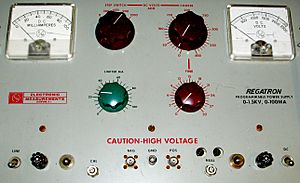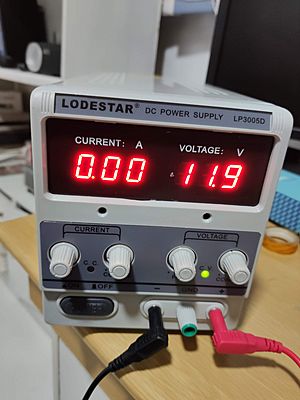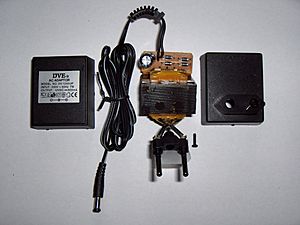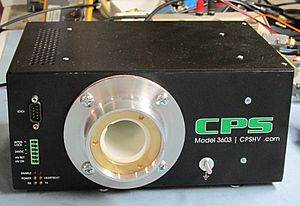Power supply facts for kids
A power supply is an electrical device that gives electric power to another electrical device. Its main job is to change electric current from a source into the right voltage, current, and frequency for the device it powers. Because of this, power supplies are sometimes called electric power converters.
Some power supplies are separate boxes, like the charger for your phone. Others are built right into the devices they power. For example, desktop computers and many other consumer electronics have power supplies inside them. Power supplies can also do other things. They can limit the current to safe levels. They can shut off power if there's an electrical fault. They can also clean up the power to stop electronic noise or voltage surges from reaching the device. Some can even store energy to keep a device running if the main power goes out, like an uninterruptible power supply.
All power supplies have a power input connection. This is where they get energy from a source. They also have one or more power output connections, often called rails. These deliver power to the device. The power source can be from the electric power grid, like a wall electrical outlet. It can also come from batteries, fuel cells, generators, solar power converters, or even another power supply. Usually, the input and output are wired connections. However, some power supplies use wireless energy transfer to power devices without wires.
Contents
Types of Power Supplies
Power supplies can be grouped in different ways. This helps us understand what they do and how they are built.
How They Work
- A regulated power supply keeps its output voltage or current steady. This happens even if the device's power needs change or the input power varies.
- An unregulated power supply does not keep its output steady. Its power can change a lot if the input voltage or device's power needs change.
- Adjustable power supplies let you change the output voltage or current. You can do this with knobs on the power supply or by using a control input.
- An isolated power supply has an output that is electrically separate from its input. This is important for safety.
How They Look (Packaging)
Power supplies come in many shapes and sizes:
- A bench power supply is a stand-alone box. People use these in labs to test and develop electronic circuits.
- Open frame power supplies have only a partial case. They are usually built inside other machines or equipment.
- Rack mount power supplies are made to fit into standard electronic equipment racks.
- An integrated power supply is built right onto the same circuit board as the device it powers.
- An external power supply is often called an AC adapter or power brick. It's a separate box on the device's power cord that plugs into a wall outlet. A "wall wart" is an external supply that plugs directly into the outlet. These are popular for home electronics because they are safe. They change the dangerous wall current (like 120 or 240 volts) into a safer voltage before it enters your device.
How They Change Power
Power supplies can be divided into two main types: linear and switching.
- Linear power supplies process the input power directly. They are simpler but can lose more energy as heat.
- Switching power supplies (SMPS) convert the input power into quick pulses. This makes them much more efficient. They lose less energy as heat. This also allows them to use smaller, lighter, and cheaper parts.
Types of DC Power Supplies
A DC power supply takes AC (alternating current) from the wall and turns it into DC (direct current). DC is what most electronic devices use.
Linear DC Power Supply
In a linear power supply, the AC input voltage first goes through a power transformer. This changes the voltage. Then, it is "rectified" (changed to DC) and "filtered" (smoothed out). The filtering can be as simple as a single capacitor. This makes the DC voltage steady. For some uses, like charging certain batteries, the power supply can be very simple, just a transformer and a diode.
Switched-Mode Power Supply (SMPS)
In an SMPS, the AC wall power is first changed directly into DC. This DC voltage is then quickly switched on and off by electronic parts. This creates a high-frequency AC current. This current then goes through a special high-frequency transformer or inductor. Because the switching is very fast (usually 10,000 to 1,000,000 times per second), the transformers and filters can be much smaller and lighter. After the transformer, the high-frequency AC is changed back to DC for the output.
SMPS are usually regulated, meaning they keep the output voltage constant. They have a feedback system that checks the power used by the device. If the device needs more power, the SMPS adjusts how long the power is "on" during each cycle.
SMPS often have safety features. These include current limiting or a "crowbar circuit." These protect the device and user from harm. For example, if too much current is drawn, the SMPS might shut down to prevent damage. Computer power supplies often send a "power good" signal. If this signal is missing, the computer won't turn on, protecting it from bad power.
Capacitive (Transformerless) Power Supply
A capacitive power supply uses a capacitor to lower the wall voltage. This reduced AC voltage is then changed to DC.
A key thing to know is that the output voltage of this type of supply is NOT isolated from the wall power. This means anything connected to it must be very well insulated to keep people safe from high voltage. Because of this, these power supplies are usually only used for very low-power devices.
Linear Voltage Regulator
A linear voltage regulator changes a varying DC voltage into a steady, often lower, DC voltage. They also often limit the current. This protects the power supply and the device from too much current.
Many devices need a constant output voltage. But the voltage from some power sources can change. A linear voltage regulator helps keep the output voltage steady. It does this even if the input voltage changes or the device's power needs change. Linear regulators can also make the output voltage smoother and reduce noise.
Types of AC Power Supplies
An AC power supply usually takes voltage from a wall outlet. It then uses a transformer to make the voltage higher or lower. Sometimes, the input voltage is the same as the output voltage. This is called an isolation transformer. Other AC power supplies, called autotransformers, do not separate the output from the wall power. A variable autotransformer is known as a variac.
Some AC power supplies are designed to give a nearly constant current. The output voltage might change depending on what the device needs. If the power source is DC, like a car battery, an inverter and transformer can change it to AC power. Portable AC power can come from a generator run by an engine.
Modern AC power supplies can be for single phase or three phase systems. They can also change the frequency, not just the voltage. Manufacturers often use them to test if their products will work in other countries. For example, they might test a product at 230 volts and 50 hertz, or 115 volts and 60 hertz.
AC Adapter
An AC adapter is a power supply built into an AC mains power plug. They are also called "plug packs" or "wall warts." AC adapters usually have one AC or DC output. This power goes through a cable to a connector. Some adapters have multiple outputs.
Adapters with AC outputs might just have a simple transformer inside. DC-output adapters can have a transformer with diodes and capacitors, or they might use switching power supply circuits. AC adapters use a small amount of power even when nothing is connected to them. This is why they are sometimes called "electricity vampires." People often plug them into power strips so they can easily turn them off.
Programmable Power Supply
A programmable power supply (PPS) can be controlled remotely. You can change its voltage, current, and even frequency (for AC outputs) using a computer or other input. They are used in many areas, like testing equipment, growing crystals, and making computer chips.
Programmable power supplies usually have a small computer inside to control them. They might use special communication rules or standard ones.
Uninterruptible Power Supply (UPS)
An uninterruptible power supply (UPS) gets power from two or more sources at the same time. It usually runs on wall power and also charges a battery. If the wall power goes out, the battery instantly takes over. This means the device never loses power. "Instantly" means very, very fast, like within milliseconds. This is important for things like high-speed data and communication services.
How long a UPS can provide power depends on its batteries and if it's connected to a generator. This can range from a few minutes to hours or even days. In many computer setups, the battery time is just enough to safely shut down the system. Other UPS systems might use an engine or turbine to provide power during an outage. These are found in hospitals, data centers, and phone companies.
High-Voltage Power Supply
A high-voltage power supply creates hundreds or thousands of volts. It uses special connectors to prevent arcing, insulation problems, and accidental contact. These are used to control electron and ion beams in equipment like x-ray generators and electron microscopes. They are also used in things like electrophoresis (separating molecules) and electrostatics.
High-voltage power supplies usually use an power inverter to drive a voltage multiplier or a special high-voltage transformer. This creates the high voltage. The high voltage then goes out through the special connector. It's also sent to a "voltage divider" which turns it into a low-voltage signal. This signal is used by a controller to keep the high voltage steady.
Bipolar Power Supply
A bipolar power supply can create both positive and negative voltages and currents. It can switch smoothly between them. When controlled by a low-level signal, it acts like a powerful amplifier. These are often used to power magnetic devices in science.
Power Supply Details
The right power supply for a device depends on its features. These are usually listed in the power supply's specification. Some common features include:
- Input voltage type (AC or DC) and its range.
- How well it converts power (efficiency).
- How much voltage and current it can give to the device.
- How steady its output voltage or current is.
- How long it can provide power without needing to be refueled or recharged (for portable ones).
- The temperatures it can work and be stored in.
- If its output is constant voltage or constant current.
Some common abbreviations you might see:
- SCP - Short circuit protection
- OPP - Overpower (overload) protection
- OCP - Overcurrent protection
- OTP - Overtemperature protection
- OVP - Overvoltage protection
- UVP - Undervoltage protection
- CV - Constant voltage
- CC - Constant current
- PFC - Power factor correction
Managing Heat
Power supplies can get hot. The more efficient they are, the less heat they make. There are many ways to cool a power supply. This usually involves moving heat away using air or other materials. Common ways include natural air flow, fans, or heat sinks.
Overload Protection
Power supplies often have protection against short circuits or overloads. These can damage the supply or even cause a fire. Fuses and circuit breakers are two common ways to protect against overloads.
- A fuse has a thin wire that melts if too much current flows. This disconnects the power supply. The device stops working until the problem is fixed and the fuse is replaced.
- A circuit breaker has a part that heats up and bends. This triggers a spring that shuts off the circuit. Once it cools down and the problem is fixed, you can reset the breaker.
Some power supplies use "current limiting." Instead of cutting off power, they just reduce the current if there's an overload.
Where Power Supplies Are Used
Power supplies are a key part of many electronic devices. Here are just a few examples:
Computers
A modern computer power supply is a switching power supply. It changes AC power from the wall into several different DC voltages. Switching supplies are used because they are cheaper, lighter, more efficient, and smaller than older linear supplies. Computers need many different voltages, and each needs a different amount of current.
Electric Vehicles
Electric vehicles use electricity for power. A power supply unit is needed to change the high voltage from the vehicle's battery into usable voltage for different parts.
Welding
Arc welding uses electricity to melt and join metals. A welding power supply provides this electricity. It can be AC or DC. Arc welding needs high currents, usually between 100 and 350 amperes. Some welding jobs use as little as 10 amperes. Others, like spot welding, use very high currents (up to 60,000 amperes) for a very short time. Older welding power supplies used transformers or generators. Modern ones use advanced electronics and even microprocessors.
Aircraft
Both commercial and military airplanes need DC-DC or AC/DC power supplies. These change energy into the right voltage for the plane's systems. They often operate at 400 hertz instead of 50 or 60 hertz. This helps save weight.
Automation
Power supplies are used in many automated systems. This includes conveyors, assembly lines, barcode readers, cameras, motors, and pumps. They are essential for manufacturing and other industrial uses.
Medical
Power supplies are vital for many medical devices. These include ventilators, infusion pumps, surgical and dental instruments, imaging equipment, and hospital beds.
See also
 In Spanish: Fuente de alimentación para niños
In Spanish: Fuente de alimentación para niños
- AC adapter
- Capacitive power supply
- Electricity generation
- High voltage
- Mains electricity by country
- Motor–generator
- Power cord
- Rectifier
- Sense (electronics)
- Voltage regulator
- Category:Power supply manufacturers









